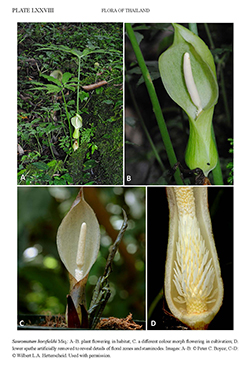e-Flora of Thailand
Volume 11 > Part 2 > Year 2012 > Page 284 > Araceae > Sauromatum
2. Sauromatum horsfieldii Miq.
in Fl. Ned. Ind. 3: 196. 1856; Schott, Prodr. Syst. Aroid.: 72. 1860; Engl. in A.DC. & C.DC., Monogr. Phan. 2: 571. 1879; in Engl., Pflanzenr. IV, 23F (Heft 73): 127. 1920; Li & Hett. in H.Li et al., Fl. China 23: 38–39. 2010.— Typhonium horsfieldii (Miq.) Steenis, Bull. Jard. Bot. Buitenzorg, III, 17: 403. 1948; Sookchaloem, Thai Forest Bull., Bot. 23: 21. 1995. Plate LXXVIII.
Accepted Name : This is currently accepted.
Synonyms & Citations :
Description : Stem a subglobose to depressed globose tuber, producing annual offsets. Leaves one or a few together; petiole 3–60 cm long, variable in colour, uniform, striped or spotted, ranging from green to purple; leaf blade pedatisect, with 7–13 lobes; lobes elliptic to lanceolate, acute, margin flat or sinuous, entire or occasionally crenate, upper surface mid to dark rich velvety green, with or without reddish main vein or splashed with golden spots along the main vein, lower surface pale to grey green, sometimes with scattered reddish purple spots. Inflorescence solitary; peduncle 2–20 cm long; spathe base convolute, ovoid, occasionally with one or a few shallow keels, top more or less constricted, outside pale or mid green, dull mid to dark brown, with or without a few reddish or blackish brown spots or stripes, inside white or whitish green; spathe limb 6–17 by 4–6 cm, ovate to oblong-ovate, cymbiform, slightly hooded, acuminate to caudate, often keeled at the midrib, outside pale or mid green, dirty greenish, dirty pale brownish, with or without a few indistinct darker spots, inside whitish, pale green, with or without a few scattered blackish purple spots; spadix shorter than spathe; pistillate flower zone cylindrical or slightly conical, 2.5–10 by 4–8 mm; ovary ovoid to oblong-ovoid, unilocular, uni- or bi-ovulate; stigma very small, in a depression of the top of the ovary or ring-like surrounding the depression; sterile zone elongate, narrowly fusiform-conical, 2–6 cm long, 3–7 mm diam. at the base, entirely covered by staminodes; lower staminodes with rhombic, flat base and aristate to clavate process, the latter strongly bent upwards, white, the clavate part yellowish white or occasionally dark red, subbasal staminodes exclusively aristate, strongly pointing upwards parallel to the spadix axis, creamish; upper staminodes fused into vertical ridges with numerous, irregular, short processes, often arranged in ridges, white; staminate flower zone cylindrical, 6–10 by 2–7 mm, upper flowers often sterile and differently shaped; staminate flowers white, the upper ones often sterile and subclavate to spathulate or occasionally aristate; appendix subsessile or more distinctly stipitate, cylindrical or rarely fusiform, 1.5–4.5 cm long, 2–6 mm diam., slightly tapering to the obtuse top, base attenuate to the stipe, surface smooth or strongly corrugate, cream or more rarely greyish brown with purple spots, stipe sometimes ridged-verrucate. Fruits with persistent spathe base; obovoid to ellipsoid, pale green when mature, corrugate and shallowly grooved.
Thailand : NORTHERN: Chiang Mai (type of Typhonium larsenii: Hu 3931, holotype -C) & type of Arisaema submonoicum Garrett 527, holotype -K, isotypes -BK), Lampang; CENTRAL: Nakhon Nayok, Saraburi (type of T. kerrii: Kerr s.n., syntype -P, isosyntypes -BK K); SOUTH-WESTERN: Kanchanaburi (type of T. kerrii: Kerr s.n., syntype -P, isosyntypes -BK K).
Distribution : SW China (types of Typhonium calcicola and T. kungmingense), SW Myanmar (type of T. pedatum), Peninsular Malaysia, Sumatra, Java (type and type of T. fallax), Bali.
Ecology : Evergreen, bamboo and deciduous forests and grasslands, on granite and limestone; 700–3,100 m alt.
Vernacular : Taphit kap khaeng (ตะพิดกาบแข็ง).
Notes: The number and disposition of the staminodes vary greatly and have been used to delimit the species regarded here as synonyms.

